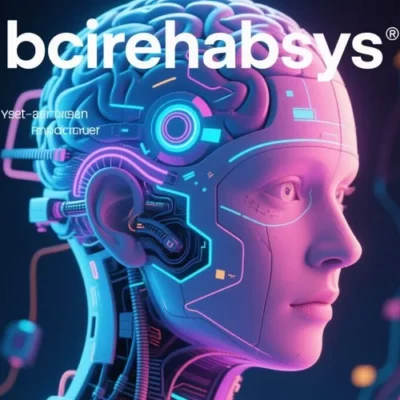
BCIRehabSys: A Comprehensive Analysis
1. Terminology and Definition
BCIRehabSys is a compound term derived from:
- BCI: Brain-Computer Interface, which connects the brain to external devices via neural signal-digitized command interactions.
- Rehab: Rehabilitation, referring to medical interventions to restore or improve bodily functions (e.g., motor, speech, cognition).
- Sys: System, a technology platform integrating hardware, software, and algorithms.
Full Definition: A brain-computer interface rehabilitation system that assists patients with neurological injuries (e.g., stroke, spinal cord injury) in functional recovery. Its core objective is to decode brain signals to drive external devices (e.g., robotic arms, VR interfaces), helping patients rebuild neuroplasticity and accelerate rehabilitation.
2. Technical Architecture and Core Modules
2.1 Signal Acquisition and Processing
- Non-Invasive Devices: EEG headsets with scalp electrodes to capture brainwave signals.
- Invasive Technologies: Implantable microelectrode arrays (e.g., Neuralink) for direct neuronal activity recording (suitable for severe paralysis).
- Noise Reduction: Machine learning algorithms (e.g., ICA) to filter environmental noise and physiological artifacts.
2.2 Neural Decoding and Intent Recognition
- Feature Extraction: Identifies motor imagery (MI), steady-state visual evoked potentials (SSVEP), and other neural patterns.
- Intent Mapping: Deep learning models (e.g., CNN, LSTM) convert brain signals into control commands (e.g., “move left hand”).
2.3 Feedback and Rehabilitation Training
- External Actuators: Robotic exoskeletons, VR environments, or functional electrical stimulation (FES) devices.
- Closed-Loop Feedback: Real-time visual/tactile feedback (e.g., virtual hand movements) reinforces neuroplasticity and brain reorganization.
2.4 Data Management and Cloud Integration
- Personalized Training: Dynamically adjusts difficulty and modes based on patient progress.
- Remote Monitoring: Clinicians optimize treatment plans via cloud-based patient data tracking.
3. Applications and Case Studies
3.1 Post-Stroke Motor Rehabilitation
- Case: Patients use EEG headsets to control virtual arms in VR through imagined movements, restoring neural pathways.
- Efficacy: Clinical studies show BCIRehabSys improves upper limb motor recovery by 30-50%.
3.2 Assistive Living for Spinal Cord Injuries
- Technology: Invasive BCI + exoskeletons to aid standing, walking, or object grasping.
- Example: BrainGate system enables paralyzed users to drink water via mind-controlled robotic arms.
3.3 Neurodegenerative Disease Management
- Parkinson’s Disease: BCI-driven FES devices reduce tremors and improve gait.
- ALS: Enables communication (e.g., letter spelling) or environmental control (e.g., light switches) via BCI.
3.4 Pediatric Neurodevelopmental Disorders
- Autism Intervention: VR social scenarios enhance emotional recognition and interaction skills.
4. Challenges and Future Directions
4.1 Current Limitations
- Signal Precision: Non-invasive BCIs (e.g., EEG) have low spatial resolution, limiting complex intent decoding.
- Individual Variability: Requires extensive personalized training due to unique brain signal patterns.
- Ethical Risks: Invasive devices pose infection, rejection, or neural data privacy concerns.
4.2 Emerging Innovations
- Hybrid BCIs: Combine EEG and fNIRS (functional near-infrared spectroscopy) for improved decoding.
- AI-Enhanced Decoding: Transfer learning reduces training time; reinforcement learning optimizes real-time control.
- Neuromodulation Integration: Pair BCI with transcranial magnetic stimulation (TMS) to boost neuroplasticity.
4.3 Commercial Potential
- Medical Market: Global neurorehabilitation devices projected to reach $15 billion by 2030, with BCIRehabSys as a key player.
- Consumer Applications: Lightweight EEG devices for focus training, meditation, or wellness management.
5. Conclusion
BCIRehabSys represents a fusion of neural engineering and rehabilitation medicine, offering hope to patients unresponsive to traditional therapies through direct “brain-machine dialogue.” As signal decoding precision improves and costs decline, this system may become standard in neurological injury treatment, driving breakthroughs in neuroscience, AI, and robotics.
If you are interested in purchasing this domain, please contact us via email: chuanchuan810@gmail.com





“BCI RehabSys” 是一个复合术语,结合脑机接口技术与康复系统的应用,其核心含义和功能可从以下维度解析:
1. 术语拆解与定义
BCI(Brain-Computer Interface):通过直接连接大脑与外部设备,实现脑电信号与计算机指令的交互,绕开传统神经肌肉通路。
RehabSys(Rehabilitation System):专为功能恢复设计的系统性医疗技术,常用于神经损伤或运动障碍患者的康复训练。
组合后指基于脑机接口的康复系统,旨在通过解码脑信号辅助患者恢复运动、语言或认知功能。
2. 技术原理与功能
信号采集与解码:通过侵入式或非侵入式电极获取脑电活动,机器学习算法解析意图(如运动想象)。
闭环反馈训练:将解码指令转化为外部设备(如机械臂、虚拟界面)的动作,实时反馈以促进神经重塑。
应用场景:帮助截瘫患者控制假肢3、语言障碍者恢复沟通1,或意识障碍患者评估残余认知功能。
3. 潜在扩展方向
神经增强:未来可能用于加速技能学习或记忆强化。
数据备份:探索脑信号与数字存储的交互,实现认知能力备份。
该术语的具体实现可能因技术方案(如侵入式/非侵入式)或厂商设计而异,但核心目标均为通过脑机交互提升康复效率。